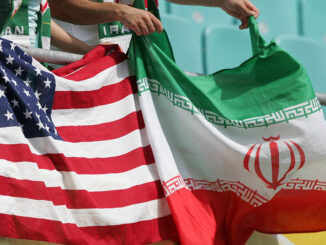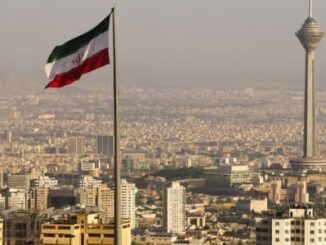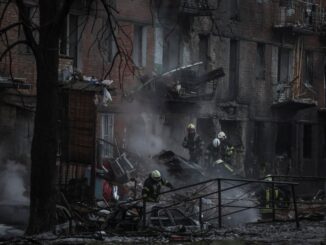
ENB Pub Note: This is the 5th in a series from George and his other articles and video can be found here on his Author page: https://energynewsbeat.co/george-mcmillian/
The tremendous global interaction and views of his landing page, podcast, and articles are amazing. Having a total “Energy Thread” covering so many different areas with huge impacting issues around the globe is viewed through an academic view with a twist. George has been around the world and in the areas he talks about. After you read all of his articles and watch the first podcast and the second soon to be released, things will start making sense. What color pill are you taking? Buckle up and follow George on his LinkedIn HERE. https://www.linkedin.com/in/george-mcmillan-5665b015/
As economist Jeffrey Sachs has been arguing over the last year and a half, the US is sleep-walking towards World War Three and the preponderance of people are not aware of the policy alternatives. The difference between political and economic development theories and the geopolitical theories needs to be more widely understood. – George McMillan
George McMillan III, CEO, McMillan and Associates and Energy News Beat Contributing Author.
The purpose for this series of articles is twofold: first, to explain the role of energy in geopolitics to people in the oil and natural gas industries, which also explains the logical coherence of American Foreign policy in the post 9/11 Global War on Terror (GWOT) era to those who were deployed overseas and are puzzled by the chaotic withdrawal from Afghanistan.
The premise is that the more one understands the history of post-Mahan ‘sea power versus sea power’ and post-Mackinder ‘sea power versus land power’ geopolitical strategies, the more one will understand the underlying reasons for the continual conflict zones of Eastern Europe and every single area of the post-colonial Eurasian perimeter.
That includes the invasion of Afghanistan and Iraq, as well as the other countries that retired General Wesley Clark discussed repeatedly in his 2007 presidential campaign; in which he claimed that there had been a “foreign policy coup” in the US and that needed to be brought to light and discussed in a democratic forum.
Since it is not the place of the more discrete government agencies of either side to disclose their strategic plans, intentions, and counter strategies, it is up to alternative media content providers to discuss possible explanations of prevailing fact patterns. This series of papers explains the history of Geopolitical thought in the context of the ongoing conflict of the sea faring colonial powers on the coastal perimeter of West Asia, South Asia, Southeast Asia and East Asia in the current era in search for answers.
The more one realizes that the current conflicts are ongoing conflicts of the past the more people will look for the underlying causes of human nature and geography which are the components of geopolitical and geostrategic thought respectively.
The Difference Between Economic Development Strategies and Mercantile Geopolitical Strategies
What is particularly useful in understanding international relations theory is the difference between political and economic development theories and geostrategic theory.
As demonstrated by my Unified Behavioral Theory of the Philosophical and Social Sciences the complete lateral integration of micro and macro human behavioral theories can be placed in terms of the two extremes of human behavior of positive-sum gain relationships versus negative-sum sabotage relationships.
Since measurement systems are based on (a) devising a nominal continuum of extremes of human behavior; (b) dividing the nominal continuum into gradations of a constructive behavioral dynamic half of the continuum and a destructive behavioral dynamic half of the continuum to attain ordinal level of measures, which (c) sets the stage for the ordinal level dichotomy to be further segmented into major categories to attain interval level measurement scales; which (d) is the prerequisite of making a causal relationship between the two in which two interval level scales can be correlated in a causal relationship to form an (X) and (Y) axis pairing where the ratio level of modeling is achieved.
It is the ratio level of modeling where the theorist can plot graphs, develop a rise/run and calculate slope to develop equations and statistical models.
Human Behavioral Frameworks
With this understanding of the four fundamental steps of theoretical model building, it is important to know that human behavior can be placed into (1) gradations of mutually beneficial positive-sum relationships on the constructive half of the behavioral continuum, (2) gradations of zero-sum extractive relationship on the first quarter of the destructive behavioral half of the continuum; and (3) negative-sum sabotage on the extreme antagonistic quarter of the most destructive end of the continuum.
It is this reality that the “real theories” of human behavior that meet the criteria of George Casper Homans “Sociological Theory” in “The Handbook of Sociology” (edited, R. E. L. Faris 1964) and John Harsanyi “Explanation and Comparative Dynamics in Social Science” (Behavioral Science, 1960), have the common element that they all have a “constructive versus destructive” behavioral dynamic.
The prime example is Aristotle’s Six Forms of Government based on the three neutral Forms of the rule of the one, the rule of the few and the rule of the many. These are valued in the Proper Forms of Monarchy, Aristocracy and Constitutional Democracy (Republic) and the Perverted Forms Tyranny, Oligarchy and Mob Rule Democracy.
The Proper Forms, in modern economic terms, are characterized by elites who invest in their own societies which leads to a higher multiplier and Gini coefficients indicative of a rising economy while the Perverted Forms are characterized by lower multiplier and Gini coefficients indicative of an extractive elite. The key feature of this framework to this article is that it is an interval level model that explains the full range of human behaviors in a singular macro framework.
Aristotle’s Six Forms is the time-tested cornerstone for the analytical system that readily integrates with Fromm’s productive versus sadomasochistic character orientation model on the initial independent variable micro-end of the model, and virtuous versus vicious economic growth cycles on the macro dependent variable end of the model; where the outcome measure framework is expressed in the categories of: First and Second First World more developed countries (MDCs) or Third and Fourth Word less developed countries (LDCs).
Since the MDCs tend to have higher levels of economic growth and lower levels of population growth, and the LDCs have lower levels of economic growth and higher levels of population growth, it is the economic growth/population growth proportions that define the wage labor market rate which ultimately defines the Geopolitical Form category when taken in a modal sense.
An Ideal World and its Discontents
The significance of this is that a utopian world comprised of Republics with democratic process as discussed in Kant’s “Perpetual Peace” 1795 can only be achieved with (a) more accurate theories of human behavior following the nomos-physis (constructive-destructive behaviors) distinction of the Ancient Greeks, and (b) the positive-sum gain aspect of political and economic development theories as explained by: Seymour Lipset in “Some Social Requisites for Democracy” (1959), Walt Whitman Rostow in “The Stages of Economic Growth: A Non-Communist Manifesto” (1960) and the role of technological innovation and infrastructure in economic growth captured in Solow-Swan models.
Of importance in this series of articles is the emphasis that Rostow placed on targeting petroleum fields, as well as delivery and storage facilities that supported the German War machine for aerial bombardment while he was working for the OSS during World War Two. He also was a strong advocate for a strategic petroleum plan for the United States to supports its allies during World War Two and afterwards during the Cold War peripheral conflicts. Today the same type of energy independence plan is needed in distinction to utopian “net-zero” ideals that the ruling coalitions in the Western “democracies” extol and the working class is skeptical of.
Rostow would later become a leading theorist on economic development theory and national security adviser to John F. Kennedy. He emphasized the importance of the US in using soft power diplomacy to guide countries through the five stages of growth: (1) traditional society, (2) pre-conditions for take-off, (3) take-off, (4) drive to maturity, and (5) high mass consumption.
The more one understands how a country must go through the five stages of growth to attain full sectoral development as discussed by Baumol and Blinder’s “Macroeconomics” (1988) text and other writings, the better one is able to understand the basis of post-Mahan and post Mackinder Grand Strategies—overt and covert geostrategic plans are based on preventing an adversary from attaining all five stages.
In contrast, the land power strategies of Friedrich Ratzel and Karl Haushofer are essentially based on the idea of land-powers using their overland logistical supply routes to attain all five stages themselves while assisting their allies to attain all five stages and full sectoral development also. (The result is a positive-sum gain relationship for the region under Proper Forms of government as defined in my Unified Behavioral Theory writings.)
The Kantian Ideal of Pareto-optimality and the Reality of Nash Equilibriums
From this simple synopsis one can see how political and economic development and modernization theory is designed to achieved positive-sum relationships enroute to a Kantian ideal, while geopolitical strategy is based on the “sole super power supremacy” of Wolfowitz (Defense Planning Guidance, FY 1994-99) and zero-sum antagonistic relationships that give rise to low intensity conflicts and the phenomenon of the “never-ending wars” that the Western middle and working classes are getting tired of.
This distinction between the role of energy in modernization theory, democratic peace and prosperity ideals, and foreign policy based on geostrategic “beggar-thy-neighbor” mercantilism needs to be understood as this series of articles progresses. As economist Jeffrey Sachs has been arguing over the last year and a half, the US is sleep-walking towards World War Three and the preponderance of people are not aware of the policy alternatives. The difference between political and economic development theories and the geopolitical theories needs to be more widely understood.
ENB Pub Note: This is the 5th in a series from George and his other articles and video can be found here on his Author page: https://energynewsbeat.co/george-mcmillian/
This is the 5th Article LinkedIn post.
This is the 4th Article LinkedIn post.



